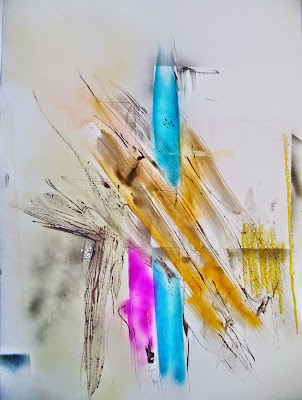Monday, 4 May 2015
For whom do you paint?
One should primarily paint for oneself, in the same manner as a composer
composes to satisfy his own standards, as a scientific and mathematics
researcher and creative thinker or philosopher reflect and work to satisfy
his own high standards.
One does not paint, think, research so as to satisfy the standards,
perceptions and likings of another, but because one must do it. The
work of the philosopher, composer, creative thinking scientist
and serious painter is not haphazard but proceed in a systematic
and logical manner.
This does not imply that the painter proceeds rationally (or merely
rationally) or by mathematical logic. Much of his work probably
are following some kind of subconscious or pre-conceptual form of
'thinking, reflection and reasoning'. But he will not merely
manufacture a work of art to please others, be it curators,
critics, gallery owners, etc. His work will proceed in some
kind of systematic manner, developing insights, techniques, forms,
structures (of perception and aesthetic thinking), composition,
forms, etc he already explored and discovered. In this way it
can be said that he builds on ideas, insights and other things
that he already has explored and discovered.
Every artist, similar to each person, has (or is?) a complex set
of aesthetic ideals, ideas and notions. These things form part of
the individual's mindset and frame of reference. many, if not most,
of these things are sub-conscious, so that the individual is not
even aware why s/he has certain 'aesthetic' and other choices,
preferences, attitudes and values. An individual's aesthetic
ideals will play a leading role in many things s/he likes and
dislikes, for example the clothes s/he wears, the way s/he
dresses, decorates the house and much else. In the case of the
artist 'aesthetic ideals' are more subtle and highly developed
than that of most 'ordinary' people. The aesthetic ideals of
the artist, especially the most creative ones, will continually
develop, change and be modified. These are the things that
constitute the artist's aesthetic mindset and vision, that play
a part in structuring the aesthetic decisions he makes and the
standards that guide these decisions and determine the choices
he makes when creating a work.
If we were to pose the question for who does the artist paint,
or create in this context, the answer will be: for himself. For
his/her own aesthetic vision, to express and realize his own
aesthetic values, to concretise his own aesthetic standards
and to make visible or give form to his own aesthetic mindset
as it is and functions at that present moment. In other words,
the artist paints in terms of his own aesthetic ideals, to
express them and to make them tangible. In this process his
mindset, aesthetic vision, ideals and frame of reference will
themselves most likely be transformed, modified and developed.
This does not imply that the artist is insular or fabricate
these things in isolation as he works in terms of the socio-
cultural norms of the discourse of (Western, etc...) visual art
in the genre of painting. He merely makes variations on,
extends, explores and develops those socio-cultural aesthetic
leading ideals, values, norms and attitudes.
4th May 2015, ulrich
Subscribe to:
Post Comments (Atom)








more DIFFERENTIATED>>>>, ulrich
ReplyDeleteyes and the aesthetic structures of the artist probably is almost more specialized, ulrich
ReplyDelete